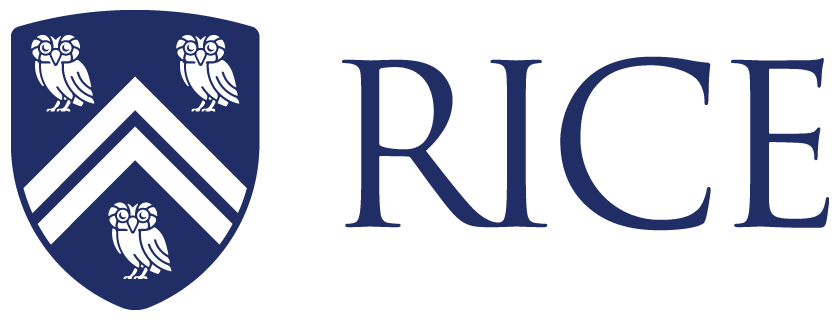- MST Program
- Advisory Council & Educational Professionals
- Application
- Courses
- ASTR502 (Fall 2025)
- ASTR503 (Spring 2026)
- ASTR530 (Spring 2025)
- PHYS501 (Fall 2024)
- Requirements
- Workshops
- Teacher Resources
- Mailing lists
- Rice Education Sites
- Center for Education
- K-12 Initiatives at Rice
- Rice School Mathematics Project
- Office of STEM Engagement
- Teacher Education at Rice
- Links
- Rice Physics & Astronomy
- Rice Space Institute
- Rice Space Science Outreach
Contact Information
Dr. Patricia Reiff | reiff@rice.edu
(713) 348-4634
Rice Space Institute, MS-108
Rice University
6100 Main Street
Houston, TX 77005-1892
Master of Science Teaching Program
A professional Masters degree for educators administered by the Physics and Astronomy Department. Approved by full Rice University faculty March 17, 2004.
APPLY NOW! Application Deadlines Oct 1 for January admission; Dec 15 for Fall admission
Teachers: Please send email to Dr. Patricia Reiff (reiff@rice.edu) if you are interested in attending any of our special teacher courses, either for credit or just as an auditor. You need not be in the MST program to take our courses. However, teachers interested in applying for the MST program are encouraged to take these classes, because up to 9 hours of Rice credit can apply to your degree. Some tuition partial scholarships are available; after those are exhausted, a special MST discounted teacher tuition rate applies. These classes are also generally open to Rice undergraduate non-majors. Both the Space and Earth programs follow a four-semester sequence, which can be begun at any time.
Summary of the MST Program:
A content-based, non-thesis, advanced degree primarily directed towards inservice middle school, IPC (Integrated Physics and Chemistry), Physics, or Astronomy high school teachers and other Education and Public Outreach (EPO) professionals. Thirty credit hours required, of which at least 15 will be content or combination content/tools courses. The remaining credits can either be content, tools, education, research, or practicum, with no more than 12 hours total in research and practicum credits. A special project is required as part of the research or practicum hours. Each student will have a 3-person committee, with at least two members from the tenure-track faculty, to approve the student's proposed program, advising which specific courses will best suit the student's needs, and approving their final project. At least one of the members of the committee will be an experienced Education Professional, who will ensure the appropriateness of the courses to the educator's program. At least one person of the committee will be an expert in the content area that is the student's primary teaching interest. The usual other MS requirements will apply; for example, no more than 9 hours can be transferred over from a Visiting Teacher credit, no more than 6 hours transfer credit, and at least 30 hours at the 500 level and above. The students apply through the Physics and Astronomy Department; GREs are not required. A 3-person committee with at least one Education Professional will review applications. Read the MST Handbook for other requirements and procedures.
The teachers who finish the program are encouraged to become master teachers in their district, multiplying the impact of the program manifold by giving workshops and other inservice programs to other teachers both in state and across the country. Many of our teachers have become NASA mission Ambassadors, e.g. Lollie Garay is a "Messenger Ambassador"; Molly Nipper and Nancy Fiegel are "Heliophysics Educator Ambassadors". Kevin Robedee (MST 2003) earned his Ph.D. in Administration in 2010, and Carol Waters (MST 2011) earned her Ed.D. in 2019 and is teaching at UHCL.
Learning Outcomes:
The students will master the following learning outcomes. The relevant course(s) where this mastery can be demonstrated are shown.- Solve Problems based on Kepler's Laws and Newton's Laws using non-calculus mathematical techniques (ASTR 502, ASTR 503)
- Demonstrate best practices for teaching scientific content. (ASTR 502; ASTR 503;ASTR 503)
- Present an oral report on a scientific topic by using Powerpoint. (ASTR 502, ASTR 503, PHYS 501)
- Learn how to use scientific and astronomical equipment such as telescopes, digital cameras, GPS, electronic devices including multimeters, and/or portable planetariums. (ASTR 530, PHYS 501)
- Prepare a Final Project, which will include scientific research, educational research, and/or curriculum creation or analysis. (Final project - PHYS 800)
- MST Handbook PDF
- MST Project Rubric PDF
- MST Project Template PDF | DOC
- Syllabus for PHYS 800 research
- Rubric for grading PowerPoint presentations
- Rubric for grading Activities for Students
- Rubric for grading demonstration of ability to set up and run a portable planetarium
- Rubric for grading demonstration of ability to setup and run an 8 inch diameter telescope
- Rubric for grading demonstration of ability to setup and run the Meade 16 inch telescope
- Advisory Council, who set policy and program direction and the
Educational Professionals, who serve on student committees to set individualized student requirements - Quicktime of "HISD Today" (14 MB) which features MST students learning ham radio along with students at HMNS summer camp. Here is a larger format (640x480, 23 MB) version of that HISD program.
- Quicktime of 2004 MST graduation: Anastasia Furitsch and Dolores Garay receiving their degrees. Here is a larger format (640x480, 9 MB) version of the 2004 graduation ceremony.
- PDF of the MST Proposal, as approved by the faculty. Note: some changes to the program may be approved from time to time by the Advisory Council, so this website and official documents from the Physics and Astronomy Department should be consulted for the most recent changes to the program.

